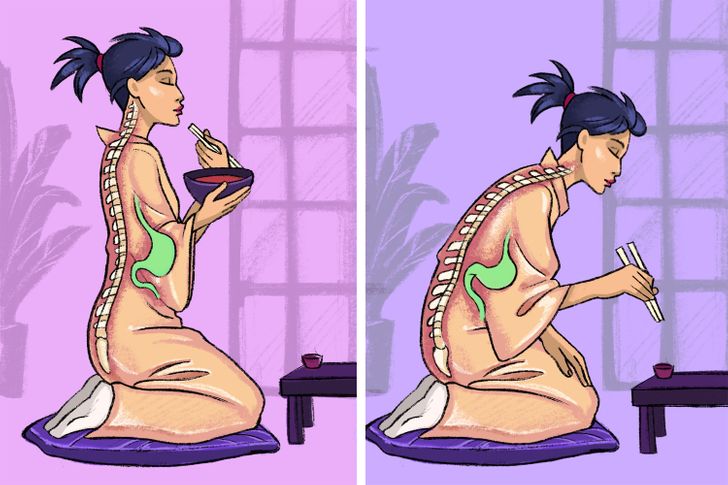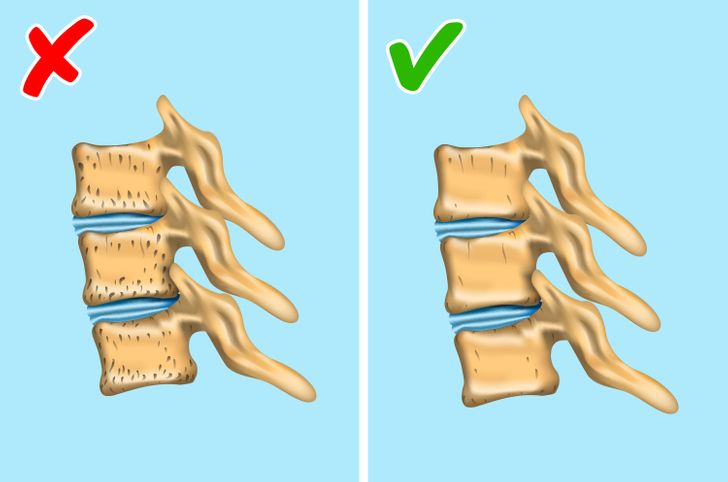In Japan, the tradition of sitting on the floor to eat is more than just a cultural practice—it’s a lifestyle choice with notable health benefits. This unique dining habit, rooted in centuries of history, offers advantages ranging from improved digestion to enhanced flexibility and even longevity. In today’s modern world, where holistic health and wellness trends are on the rise, understanding the benefits of traditional practices can provide valuable insights into sustainable living.
This comprehensive article delves into why people in Japan sit on the floor to eat. We’ll explore how this practice may help digestion, support weight loss, improve flexibility, promote a longer life, and keep your joints healthy.
Let’s take a closer look at each benefit and understand why this ancient custom continues to be relevant in modern wellness practices.
It Helps Digestion: Enhancing Your Body’s Natural Processing

One of the primary reasons floor seating is favored in Japan is its positive impact on digestion. Sitting on the floor encourages an upright posture, which can facilitate better digestion and nutrient absorption.
How Floor Seating Improves Digestion
Postural Alignment:
When you sit on the floor, you are naturally encouraged to maintain an upright posture. This alignment helps the stomach and intestines function optimally by allowing food to move smoothly through the digestive tract. An aligned posture reduces compression on the abdomen, which can improve the efficiency of digestive processes.
Mindful Eating:
Floor seating often comes with a more relaxed dining atmosphere. This setting encourages mindful eating, where you take the time to chew your food thoroughly and savor every bite. Slower, more mindful eating can lead to better digestion and reduce the likelihood of overeating.
Natural Core Engagement:
Sitting on the floor engages your core muscles, which supports better posture and overall digestive health. A strong core can help regulate the digestive system and prevent issues like acid reflux or bloating.
For further insights into how posture influences digestion, you can read Harvard Health Publishing’s article on the benefits of mindful eating and posture.
It May Help You Lose Weight: Boosting Metabolism Through Natural Movement

Weight management is a key component of overall health, and the way you sit during meals can influence your metabolism. The practice of sitting on the floor to eat may contribute to weight loss by promoting calorie-burning and mindful food consumption.
The Connection Between Floor Seating and Weight Loss
Calorie Expenditure:
Sitting on the floor requires slight muscle engagement to maintain balance and posture. Over time, this natural muscle use can contribute to increased calorie expenditure compared to sitting in a chair, where support is provided by the furniture.
Mindful Portion Control:
When dining on the floor, meals are often served in smaller, more traditional portions. This can naturally lead to portion control, helping you avoid overeating. Smaller portions, combined with mindful eating practices, can prevent excess calorie consumption.
Enhanced Metabolic Activity:
The act of sitting on the floor and engaging your core muscles can stimulate your metabolism. This subtle physical activity, accumulated over the day, may help boost overall metabolic rates, assisting in weight loss efforts.
For more on how mindful eating and natural movement can aid weight loss, visit WebMD’s weight management tips.
It Makes You More Flexible: Improving Mobility Through Traditional Seating

Flexibility is an essential component of overall physical health, and the traditional Japanese practice of floor seating can significantly enhance your flexibility. This method of dining promotes a range of benefits that extend beyond the meal itself.
How Floor Seating Enhances Flexibility
Regular Stretching:
Sitting on the floor naturally encourages you to stretch your legs and back. Over time, this regular stretching can lead to improved flexibility in your hips, knees, and lower back. Unlike chairs that confine your body, floor seating allows for a greater range of motion.
Increased Range of Motion:
Floor seating often requires you to cross your legs or sit in positions like seiza (kneeling) or zabuton-style. These positions can increase your joint mobility and contribute to a greater range of motion, which is beneficial for overall physical health and injury prevention.
Balance and Coordination:
Maintaining balance while sitting on the floor engages your core and lower body muscles. This exercise enhances your balance and coordination, which is essential for daily activities and overall fitness.
For additional insights on improving flexibility through traditional practices, explore Verywell Fit’s guide on flexibility and mobility.
It May Help You Live Longer: Promoting Longevity Through Lifestyle Choices

Longevity is a highly sought-after goal, and many studies suggest that certain lifestyle choices can contribute to a longer, healthier life. The Japanese lifestyle, including practices like floor seating, is often linked to longevity and overall well-being.
The Longevity Connection with Floor Seating
Stress Reduction:
Floor seating fosters a more relaxed and grounded dining experience, which can help reduce stress. Lower stress levels are associated with decreased risk of chronic diseases, such as heart disease and diabetes, and contribute to a longer life.
Active Lifestyle:
The Japanese lifestyle is renowned for its emphasis on movement and physical activity. Sitting on the floor encourages regular, low-level activity that can complement other aspects of an active lifestyle, ultimately promoting better cardiovascular health and longevity.
Holistic Wellness:
Incorporating traditional practices like floor seating into your daily routine aligns with a holistic approach to health. This integration of cultural practices and physical well-being contributes to improved mental and physical health, factors that are crucial for a long, fulfilling life.
For further research on lifestyle and longevity, check out The Japan Times on Japanese longevity.
It Keeps Your Joints Healthy: Reducing Strain Through Natural Posture

Joint health is a vital aspect of overall wellness, and maintaining proper posture can reduce the strain on your joints. Floor seating encourages natural, balanced positioning that can help keep your joints in optimal condition.
Benefits of Floor Seating for Joint Health
Natural Alignment:
Sitting on the floor promotes a neutral spine position, which reduces undue stress on the knees, hips, and lower back. This natural alignment can help prevent joint wear and tear over time.
Improved Circulation:
Floor seating allows for better blood flow throughout the body. Enhanced circulation supports joint health by delivering essential nutrients and oxygen to these areas, facilitating repair and reducing inflammation.
Reduced Sedentary Behavior:
Traditional Japanese practices often include regular transitions between sitting, standing, and moving. This dynamic approach to posture prevents the prolonged static positions that can lead to joint stiffness and discomfort.
For more detailed information on joint health and posture, visit Mayo Clinic’s resources on joint care.
Integrating Floor Seating into Your Modern Lifestyle
Adopting the practice of sitting on the floor to eat might seem daunting at first, especially if you’re used to chairs and tables. However, with a few adjustments, you can incorporate this beneficial habit into your daily routine without sacrificing comfort.
Tips for Transitioning to Floor Seating
Start Slowly:
If you’re not accustomed to sitting on the floor, begin by incorporating floor seating for short periods. Consider using cushions or a zabuton (a traditional Japanese floor cushion) for added comfort.
Practice Good Posture:
Focus on maintaining an upright posture with your back straight and shoulders relaxed. This will enhance the benefits of floor seating and prevent discomfort.
Alternate Seating Options:
You don’t have to give up your chair entirely. Alternate between sitting on the floor and using a chair to gradually build your flexibility and core strength.
Incorporate Stretching:
Before and after your meals, do some light stretching to prepare your body and relieve any tension. This practice can further enhance digestion and joint health.
Mindful Eating:
Use floor seating as an opportunity to practice mindful eating. Take your time, enjoy your food, and focus on the sensory experience, which can improve digestion and overall satisfaction.
By gradually integrating these practices, you can experience the numerous health benefits of floor seating without feeling overwhelmed by a sudden change in your routine.
Cultural Insights: The Tradition Behind Floor Seating in Japan
The practice of sitting on the floor to eat is deeply embedded in Japanese culture, reflecting values of simplicity, mindfulness, and harmony with nature. This tradition is not only about physical benefits but also about fostering a connection to cultural heritage and community.
Cultural and Social Aspects
Mindfulness and Presence:
Japanese dining culture emphasizes mindfulness and the appreciation of food. Floor seating creates an intimate setting that encourages slow, deliberate eating and social interaction.
A Sense of Community:
Sharing meals on the floor often involves sitting in close proximity to family and friends. This fosters a sense of community and connectedness, which is essential for emotional well-being.
Heritage and Simplicity:
The simplicity of floor seating reflects traditional Japanese aesthetics and a respect for nature. This minimalist approach can inspire a more mindful, balanced lifestyle that extends beyond the dining table.
For more on Japanese cultural practices and their health benefits, explore Japan Today’s cultural insights.
Conclusion: Embrace the Benefits of Floor Seating for a Healthier, Balanced Life
The tradition of sitting on the floor to eat in Japan offers more than just cultural significance—it provides tangible health benefits that are relevant in today’s fast-paced world. From improved digestion and weight management to enhanced flexibility, longevity, and joint health, the practice of floor seating can be a transformative addition to your lifestyle.
By integrating floor seating into your daily routine, you not only honor a rich cultural heritage but also promote a holistic approach to wellness. Whether you’re looking to improve your digestive health, boost your metabolism, or simply enjoy a more mindful dining experience, this ancient practice holds valuable lessons for modern living.
Remember, the transition to floor seating doesn’t have to be abrupt. Start slowly, incorporate supportive elements like cushions, and enjoy the process of discovering a new way to enhance your well-being. With consistency and mindful practice, you may find that this simple change brings profound benefits to your health and overall quality of life.
For further expert advice and insights on healthy lifestyle practices, check out reputable sources like Harvard Health Publishing and Mayo Clinic. Embrace the wisdom of traditional practices and experience firsthand why the Japanese way of dining might just be the key to a healthier, more balanced you.
By adopting this time-honored approach, you are taking a proactive step toward improving your overall health—one mindful meal at a time. Enjoy the journey to better health and discover how the simple act of sitting on the floor to eat can positively impact your life.









Leave a Reply